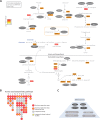Methionine coordinates a hierarchically organized anabolic program enabling proliferation
- PMID: 30354837
- PMCID: PMC6340205
- DOI: 10.1091/mbc.E18-08-0515
Methionine coordinates a hierarchically organized anabolic program enabling proliferation
Abstract
Methionine availability during overall amino acid limitation metabolically reprograms cells to support proliferation, the underlying basis for which remains unclear. Here we construct the organization of this methionine-mediated anabolic program using yeast. Combining comparative transcriptome analysis and biochemical and metabolic flux-based approaches, we discover that methionine rewires overall metabolic outputs by increasing the activity of a key regulatory node. This comprises the pentose phosphate pathway (PPP) coupled with reductive biosynthesis, the glutamate dehydrogenase (GDH)-dependent synthesis of glutamate/glutamine, and pyridoxal-5-phosphate (PLP)-dependent transamination capacity. This PPP-GDH-PLP node provides the required cofactors and/or substrates for subsequent rate-limiting reactions in the synthesis of amino acids and therefore nucleotides. These rate-limiting steps in amino acid biosynthesis are also induced in a methionine-dependent manner. This thereby results in a biochemical cascade establishing a hierarchically organized anabolic program. For this methionine-mediated anabolic program to be sustained, cells co-opt a "starvation stress response" regulator, Gcn4p. Collectively, our data suggest a hierarchical metabolic framework explaining how methionine mediates an anabolic switch.
Figures








Similar articles
-
Methylated PP2A stabilizes Gcn4 to enable a methionine-induced anabolic program.J Biol Chem. 2020 Dec 25;295(52):18390-18405. doi: 10.1074/jbc.RA120.014248. Epub 2020 Oct 29. J Biol Chem. 2020. PMID: 33122193 Free PMC article.
-
Differential stability of Gcn4p controls its cell-specific activity in differentiated yeast colonies.mBio. 2024 May 8;15(5):e0068924. doi: 10.1128/mbio.00689-24. Epub 2024 Apr 16. mBio. 2024. PMID: 38624209 Free PMC article.
-
Genome-scale reconstruction of Gcn4/ATF4 networks driving a growth program.PLoS Genet. 2020 Dec 30;16(12):e1009252. doi: 10.1371/journal.pgen.1009252. eCollection 2020 Dec. PLoS Genet. 2020. PMID: 33378328 Free PMC article.
-
The pleiotropic effects of the glutamate dehydrogenase (GDH) pathway in Saccharomyces cerevisiae.Microb Cell Fact. 2018 Nov 1;17(1):170. doi: 10.1186/s12934-018-1018-4. Microb Cell Fact. 2018. PMID: 30384856 Free PMC article. Review.
-
Ammonia assimilation by Saccharomyces cerevisiae.Eukaryot Cell. 2003 Oct;2(5):827-9. doi: 10.1128/EC.2.5.827-829.2003. Eukaryot Cell. 2003. PMID: 14555464 Free PMC article. Review. No abstract available.
Cited by
-
Bend or break: how biochemically versatile molecules enable metabolic division of labor in clonal microbial communities.Genetics. 2021 Oct 2;219(2):iyab109. doi: 10.1093/genetics/iyab109. Genetics. 2021. PMID: 34849891 Free PMC article. Review.
-
Methionine restriction constrains lipoylation and activates mitochondria for nitrogenic synthesis of amino acids.Nat Commun. 2023 May 2;14(1):2504. doi: 10.1038/s41467-023-38289-9. Nat Commun. 2023. PMID: 37130856 Free PMC article.
-
Regulation of translation by one-carbon metabolism in bacteria and eukaryotic organelles.J Biol Chem. 2021 Jan-Jun;296:100088. doi: 10.1074/jbc.REV120.011985. Epub 2020 Nov 21. J Biol Chem. 2021. PMID: 33199376 Free PMC article. Review.
-
Targeting Methionine Synthase in a Fungal Pathogen Causes a Metabolic Imbalance That Impacts Cell Energetics, Growth, and Virulence.mBio. 2020 Oct 13;11(5):e01985-20. doi: 10.1128/mBio.01985-20. mBio. 2020. PMID: 33051366 Free PMC article.
-
Low intake of essential amino acids and other risk factors of stunting among under-five children in Malang City, East Java, Indonesia.J Public Health Res. 2021 Apr 14;10(2):2161. doi: 10.4081/jphr.2021.2161. J Public Health Res. 2021. PMID: 33855394 Free PMC article.
References
Publication types
MeSH terms
Substances
Grants and funding
LinkOut - more resources
Full Text Sources
Molecular Biology Databases
Research Materials

